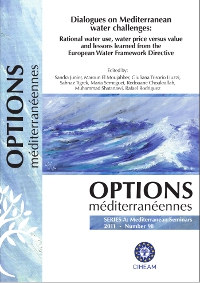| Article précédent | p. 97-106 | Article suivant |
Potential groundwater contamination by toxic metals around an abandoned iron mine, Bekkaria (Algeria)
This study evaluates potential groundwater contamination with toxic metals in and around an abandoned iron mine in Algeria. The studied mine is situated in East Algeria near the frontier with Tunisia. The exploitation of the iron mine terminated in 1967, however, our present interest is the impact of the mine's waste heaps on the groundwater and surface water in the area. Two aquifers are present, the first is situated at three metres under the ground and is connected with the wadi Oued el Kebir; the second is situated at 20 metres deep. The traces of water in the mine waste dump indicate that during the period of peak stream flow, as a result of snowmelt runoff, a losing stream exists that facilitates the displacement of pollutants. The performed analysis permitted us to study the presence of Metal Trace Elements (MTE) in the first aquifer and the wadis. The electrical conductivity near the mine is very high, this is explained by the high concentrations of sulphates, chlorides, calcium and sodium. The spatial variation of the chemical concentrations observed is probably related to the transport of dissolved chemicals from the iron mine waste. The graphs of the results show high concentrations of MTE reducing with the distance to the mine. The neural network modelling performed, confirms this conclusion.
La mine de fer est située dans l'extrême Est algérien. Son exploitation s'est arrêtée en 1967. Nous nous intéressons à l'impact de cette mine abandonnée sur les eaux souterraines et les eaux de surface. Ce qui revient à l'évaluation de la contamination potentielle des eaux par les métaux toxiques dans la zone de dépôt des terrils. La zone d'étude recèle deux aquifères, le premier, très proche du sol, est en relation avec le wadi Oued el Kebir, le second est situé à 20 mètres de profondeur. Les précipitations entraînent le déplacement des terrils et des polluants, contribuant ainsi à la pollution des eaux et des sols. Les analyses réalisées montrent l'évolution des ETM (Elément Trace Métallique), dans les deux aquifères. Nous remarquons que la conductivité électrique est très élevée près de la zone de dépôts des terrils, elle est induite par les fortes concentrations en sulfates, en chlorures, en calcium et en sodium. Les concentrations observées sont générées par dilution. Les teneurs en éléments traces diminuent en s'éloignant de la zone de dépôt des terrils. La modélisation par la méthode des neurones artificiels confirme les résultats obtenus par l'hydrochimie.
- [ Afficher ]
- [ Télécharger ]
- [ Exporter la citation ]
Vous pouvez télécharger la citation au format :
- [ Imprimer ]
-
Mots-clés
ALGERIE, EAU SOUTERRAINE, EAU SUPERFICIELLE, ELEMENT METALLIQUE, POLLUTION DE L'EAU, RESEAU DE NEURONESCiter cet article
Greib L., Djabri L., Hani A., Bouhsina S., Mudry J., Sharour I. Potential groundwater contamination by toxic metals around an abandoned iron mine, Bekkaria (Algeria). In : Junier S. (ed.), El Moujabber M. (ed.), Trisorio-Liuzzi G. (ed.), Tigrek S. (ed.), Serneguet M. (ed.), Choukr-Allah R. (ed.), Shatanawi M. (ed.), Rodríguez R. (ed.). Dialogues on Mediterranean water challenges: Rational water use, water price versus value and lessons learned from the European Water Framework Directive. Bari : CIHEAM, 2011. p. 97-106. (Options Méditerranéennes : Série A. Séminaires Méditerranéens; n. 98). 3. MELIA Workshop Water Value Impacts on the Mediterranean Water Policies, 2009/03/21-23, Istanbul (Turkey); 4. MELIA Workshop Benchmarking Exercise and Recommendations on the Application of the Water Framework Directive, 2010/03/21-26, Amman (Jordan). http://om.ciheam.org/om/pdf/a98/00801472.pdf



